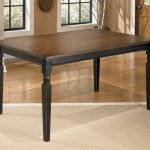How to Paint an Adjoining Living Room and Dining Room
Painting an adjoining living room and dining room can be a daunting task, but it doesn't have to be overwhelming. With careful planning and execution, you can transform these spaces into a unified and stylish haven. This article provides a step-by-step guide to help you navigate the process effectively.
1. Planning and Preparation
Before you even pick up a paintbrush, it is essential to carefully plan and prepare your living and dining room for a successful paint job. This stage sets the foundation for a smooth and efficient painting experience.
a. Assess Your Space
Start by taking a good look at your living and dining room. Consider the size, shape, and overall character of the space. Note the existing décor, including furniture, artwork, and lighting. This initial assessment will help you determine the best paint colors and finishes for the rooms.
b. Decide on a Color Scheme
Choose a color scheme that complements the existing décor and your personal style. You can opt for a monochromatic palette for a cohesive look or create contrast with two or three complementary colors. Consider the natural light in your rooms and the desired mood. For example, warm colors can make a space feel cozy, while cool colors can create a calming atmosphere.
c. Gather Supplies
Once you have chosen your paint colors, gather all the necessary supplies. This includes:
- Paint
- Paint brushes and rollers
- Drop cloths and painter's tape
- Paint thinner or cleaner
- Stir stick
- Paint tray and liner
- Sandpaper
- Putty knife
- Ladder or stepstool
- Protective clothing
d. Protect Surfaces
Before you start painting, protect your furniture, floors, and other surfaces with drop cloths and painter's tape. Cover furniture with plastic sheeting or move it to a different room. Tape off areas that you don't want to paint, such as trim, moldings, and windows.
e. Prepare the Walls
Clean and prepare your walls for a smooth and even paint finish. Remove any existing wallpaper, dirt, or debris. Patch any holes or cracks with spackle or patching compound. Sand the patched areas smooth and prime the walls with a primer compatible with your chosen paint.
2. Painting Techniques
With planning and preparation complete, you can now focus on the actual painting process. Here are some tips for achieving a professional-looking finish:
a. Paint the Trim
Start by painting the trim and moldings. This step is often best done with a brush, allowing for precision and detail. Use a high-quality paintbrush designed for trim work and apply thin, even coats of paint.
b. Roll the Walls
Once the trim is dry, you can start painting the walls. Use a high-quality paint roller and apply thin, even coats of paint. Roll in a W pattern, overlapping each stroke by about an inch. Ensure you apply sufficient layers to achieve full coverage.
c. Cut in the Edges
After applying the first coat of paint to the walls, use a brush to cut in the edges around windows, doors, and trim. This will create a crisp and clean line between the walls and the trim.
d. Apply a Second Coat
After the first coat of paint is dry, apply a second coat to ensure even coverage and a rich, vibrant color. Allow each coat of paint to dry thoroughly before applying the next.
3. Finishing Touches
Once the paint is dry, it's time to add the finishing touches to complete your transformation.
a. Remove Tape
Carefully remove the painter's tape from the walls and trim. Remove the tape while the paint is still wet to avoid pulling off any paint.
b. Clean Your Brushes and Rollers
Clean your brushes and rollers thoroughly with paint thinner or cleaner. Allow them to dry completely before storing them.
c. Finishing Touches
After the paint is dry, return the furniture and accessories to their original positions. You may want to consider adding new curtains or rugs to complete the look.

How To Connect Rooms With Cohesive Color Flow True Value Hardware

Connecting Rooms With Color

Interior Design How To Decorate Adjoining Living Room And Dining Mumsnet

Family Room And Adjoining Kitchen

Ask Maria How To Transition Paint Colours In An Open Concept Home

How To Paint Open Concept And Two Story Spaces Big Dog Painting

How To Decorate An Open Plan Kitchen Living Room Dulux
What Color To Paint Doorway Walls Between Rooms

How To Decorate An Open Plan Kitchen Living Room Dulux

What Color To Paint Doorway Walls Between Rooms








